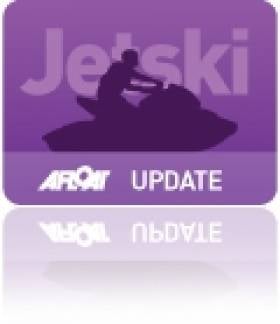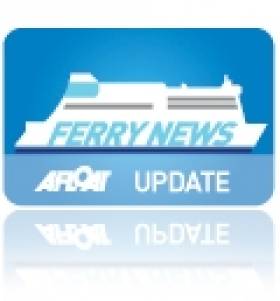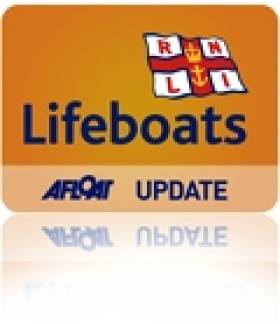Displaying items by tag: Holyhead
Jet Ski Driver - Are You in Control?
Jetski – The UK Coastguard and North Wales Police are reminding people of the dangers of jet skis and personal watercraft (PWC) ahead of what is hoped will be a busy summer in North Wales.
Last summer Holyhead Coastguard dealt with almost 35 incidents involving PWCs. These ranged from mechanical issues, running out of fuel or even concern that PWCs were too close to shore or endangering swimmers.
In one incident a man and a woman suffered serious injuries after two jet skis collided near Porthmadog and over the same weekend a youngster in Abersoch sustained minor injuries after the kayak he was in was struck by a jet ski.
Ray Carson, Rescue Coordination Centre Manager at Holyhead Coastguard, said:
"The majority of PWC users are responsible and often assist us during search and rescue incidents. However, during the summer months we do receive complaints that jet skis and PWCs have gone too fast and too close to shore. This is concerning to us as it's putting swimmers and other beach-goers in danger. You should check if any bylaws are in place, stick to them and be respectful of others in the water.
"You also need to make sure you know how to operate these powerful machines. The last thing you want is to find yourself in the water after being thrown off. This is why we always recommend that you get yourself trained, wear a buoyancy aid and ensure you're using a kill cord, so if you end up in the water, the engine will stop. Remember, if you see anyone in difficulty at the coast, call 999 and ask for the Coastguard."
Dewi Jones, the newly appointed Police Inspector for South Gwynedd, added:
"Incidents involving inappropriate, unsupervised or careless use of sometimes powerful marine craft impact upon all the emergency services when our resources may be required elsewhere. Last summer at least three people sustained significant injuries. Two of those could have been a lot worse. Working with HM Coastguard, RNLI and other emergency services we'd ask that all marine craft users to adhere to safety advice, act responsibly and consider others in the water so everyone can enjoy the pleasures of our beautiful beaches and seas."
#isora – A former steel hulled BT Global Challenge yacht was the winner of a 'punishing' second ISORA offshore race from Holyhead to Dun Laoghaire on Saturday morning. The 15–boat fleet faced a fetch into 30 plus knots of wind that veered to produce a beat at the end of the 60–miler as the boats apporached the Dublin coastline. See results for download below as a jpeg file.
Conor Fogarty's entry SY 2041' made the best of the Irish Sea's harsh conditions, another good preparation race for next month's 700–mile Round Ireland race.
One great ISORA racer and supporter lost its mast on Friday night, just north of Holyhead when heading for the race start area. The Isle of Man based Sigma 33, Polished Manx skippered by Kuba Szymanski ended up being towed to Holyhead by the RNLI.
Holyhead's all weather Severn class RNLI lifeboat launched to the 33ft–yacht dismasted in a force seven gale at 2.20am, according to RNLI sources.
The ISORA entry had got into difficulties eight miles out when its mast broke leaving the vessel 'helpless in huge seas' off the Skerries light. The coxswain asked if the yacht crew were able to cut free the rig as weather conditions made it hazardous to pass lifeboat crew to assist in the big sea swell. This was done and the lifeboat escorted Polished Manx under her own power to Holyhead marina, a journey of some six hours. Holyhead coastguard co-orientated the callout.
Szymanski, who has raced thousands of miles including last year's D2D and Fastnet races, has made contact with ISORA commodore Peter Ryan to say he aims to be back on the startline with a new mast for the next ISORA on May 24th. 'If it can be done, he is the man to do it', says Ryan.
ISORA Race 2 (Holyhead to Dun Laoghaire) Report by Peter Ryan:
As with Race 1, the weather was not kind to ISORA competitors. Strong and gusty conditions all the previous week with DBSC cancelling their Thursday racing did not encourage those skippers who were considering taking part in the race from Holyhead to Dun Laoghaire. Although a window of opportunity arose for boats delivering on Friday only 15 boats came to the line at 08.30 on Saturday 10th May. The usual start time was delayed due to shipping movements.
As the boats left Holyhead marina and made their way in the strong and gusty southerly winds to the start line between the pier head an Clipera bouy, they were met by the ominous sight of one of our fellow competitor Kuba Szymanski's "Polished Manx", with no rig, being escorted by Holyhead lifeboat towards the marina. Thankfully all were safe aboard.
There was concern about the weather forecast for the race when the Sailing Committee met on Friday evening at the pre-race soiree in Holyhead sailing Club. After the usual consideration and consultation there was unanimous agreement to make the race as short as possible – from the start direct to the finish.
The forecast for the race was for Force 6-7 south west veering west later and decreasing towards the Irish coast. Some parts of that forecast were incorrect – the wind only moderated for a time and it touched at Gale 8 several times. The race started with a southerly Force 7 and soon most boats had reefed down for the weather. Holyhead boat "Pipedreamer" did not start as they tore their mainsail while putting it up.
Things did not appear too bad as the fleet left the line and headed west towards Dun Loaghaire. Anyway, not until they reached the overfalls and out of the lee of the North Stack!!! Luckily the wind was from the south and allowed most boats to avoid most waves as they broke around them.
Quickly into the lead were the "big boats" "2041" the Challenge 67, "Mermaid IV" Beneteau First 50 and Andrew Hall's J125, "Jackknife". It was the Past ISORA Chairman's first race since retiring from offshore several years ago. Very soon the fleet split into three groups – the "big boats", the three J109's and Adelie and the rest.
Many boats took a southerly course to prepare for the veering wind. However the wind, that varied in strength from 18 to 34 knots, did not appear to have read the forecast. When the boats were only 20 miles off Dun Laoghaire there was no sign of the westerly wind. Most boats then took a more northerly course toward the finish.
Then as the leaders approached the Kish bank, the squalls appeared and with them driving rain and veering winds, resulting in a beat for the last 15 miles to the finish for most boats.
There was close racing is all the groups. At the front, "Jackknife" just squeezed over the finish line for line honours with only 90 seconds separating them from "2041". The J109's had a close match all during the race with positions being changed between them several times. The three J109's "Ruth", "Mojito" and "Sgrech" were never more than a few hundred metres apart at any time. When they were forced to beat towards the end of the race, there was separation. "Ruth" managed to nose 60 seconds ahead of her level rated opponent "Sgrech" as they crossed the finish line. "Mojito" finished 90 seconds behind "Sgrech"
"2041" took the Overall and Class1 win while "Adelie" took Class 2. "Yahtzee" took the Silver Class.
The tired, wet and battered crew made their way back to the National Yacht Club for the usual "après sail" and the regular discussion about "Why in God's name do we race offshore???"
Those crew off boats who did not compete, followed the race using the AIS trackers. Facebook commentary on the progress of the race was provided by, past two handed and currently one-handed offshore sailor, Liam "Lula Belle" Coyne and also by Andrew "Jedi" Sarratt. The commentary demonstrated the potential effect of the tracking for the general public interest in the offshore racing. Only four boats managed to successfully use the "Predictwind" tracker. As the tracking is becoming a huge part of the offshore racing scene. A big push will be made to get more boats "activated" for the next race.
The next race takes place on the 24th May and acts as a feeder to get boats some of the way towards Liverpool for the Liverpool – IOM – Dun Laoghaire weekend on the first weekend in June.
Holyhead Lifeboat's Decade Of Lifesaving
#RNLI - Holyhead RNLI volunteers are coming together to mark the 10th anniversary of their all-weather lifeboat that safeguards waters familiar to many an Irish ferry passenger.
To celebrate the milestone, the volunteer RNLI crew have commissioned a decorative bell paying tribute to each volunteer who has served aboard Christopher Pearce.
The bell will be unveiled to the volunteer crew who will also receive an anniversary glass this Wednesday 18 December.
Launching 205 times since entering service at Holyhead, Christopher Pearce - the only Severn class lifeboat of her kind in Wales - has rescued 307 people.
A total of those 11 people rescued owe their lives to the volunteer crew and would not be celebrating Christmas this year had Christopher Pearce not come to their rescue.
The vessel – which is named after Christopher Pearce, who bequeathed the money before his death in 1997 – has seen some unique, challenging and difficult rescues during its 10 years on station.
In 2006 the all-weather lifeboat saw some of its most unusual rescues. A swan-shaped pedalo drifting in a busy shipping lane 25 miles out to sea required their assistance during the summer.
Then two young Irish men who stole a fishing trawler to sail home across the Irish Sea after missing the last ferry required their assistance after sailing in circles around the Anglesey coast.
In 2007, the all-weather lifeboat was launched to the large vessel Smitt Cymran which had hit rocks and was sinking seven miles out of Holyhead. The five people were lifted off by RAF sea king helicopter. The volunteer lifeboat crew worked hard to keep vessel afloat.
More recently, in 2011, Christopher Pearce was launched to assist other North Wales lifeboats in searching for missing men after the cargo ship Swanland sank.
The volunteer crew had to contend with Force 9 winds into a very rough and confused sea. Two crew members were rescued alive from the ship but five other crew members were never found.
"Ten years does not seen like a long period of time," commented Holyhead RNLI lifeboat press officer Ray Steadman, "but the changes Holyhead RNLI has seen over the years have been phenomenal.
"We’ve seen the introduction of new lifejackets and training is more intense than ever before. We’ve seen people come through the door as youngsters develop into fully fledged competent crew members. Single people walked through the door who are now married, with families of their own but the commitment is still as strong as it ever was.
"Ten years on, these people still appear in freezing conditions, the cold and the rain to drop everything they are doing to help people in trouble at sea. At Christmas or any other time of the year, that’s the level of commitment required to become an RNLI volunteer and we are looking forward to celebrating that dedication."
Full-time coxswain Brian Thomson, who has led his crew through some difficult rescues, added: "Since Christopher Pearce arrived on station she has served the volunteer crew exceptionally well. We have seen some challenging and unique rescues in difficult conditions, but myself and the crew have every confidence in their lifeboat which has grown during the last decade when she has battled gales and rough seas.
"As people around the country prepare for Christmas, we have our own very special cause for celebration in Holyhead and will felt it was only right to mark the occasion with a lasting reminder of those who have served on our much-loved lifeboat Christopher Pearce.
"The specially commissioned bell is a gift from all the crew to each other which reflects how life boating is all about teamwork and having trust in one another."
A second lifeboat, financed by a legacy from Pearce's brother Andrew after his death in 1988, is stationed at Llandudno and is named Andy Pearce.
The men's mother, Diana Pearce from Cheshire, asked for the money left by her son Christopher to be specifically used for the Holyhead lifeboat, remembering the holidays the family enjoyed in North Wales when the boys were younger.
When the Herald of Free Enterprise ferry sank in the English Channel in 1987, the government and the RNLI agreed that a fast Severn class lifeboat should be at every major ferry port. Holyhead was one of the last stations in the UK to have the improved vessel stationed there - but it is the first in Wales.
Irish Ferries Increases Capacity on Irish Sea Dublin to Holyhead Route
#ferry – Irish Ferries is to increase its capacity and frequency on the Dublin to Holyhead route through the introduction of a third ship in December 2013.
Currently, the ferry company operates eight sailings per day on the key Irish Sea route using its flagship Ulysses and the High Speed Craft Jonathan Swift.
Irish Ferries has chartered the Epsilon (2011 built ) to supplement its existing Ireland to Britain services. The ship will provide two additional departures per day in each direction which will result in an increase in the company's schedule to a maximum of twelve sailings between Dublin and Holyhead each day. The recently built vessel will provide significant vehicle capacity along with modern facilities on board including cabins, bar/cafeteria and self-service restaurant.
Targeting the growing Freight and Tourism markets, the Epsilon will further improve Irish Ferries' range of offers to its customers on the Irish Sea. In addition to the improved frequency on its Dublin to Holyhead route, the chartered vessel will also provide opportunities for improved annual dry-dock cover within the company's fleet along with scope for increased capacity on other Irish Ferries' Irish Sea and Ireland to France services.
Commenting on the announcement, Irish Ferries' Marketing Director, Tony Kelly, said, "Irish Ferries decision to invest in additional capacity at this time is a major vote of confidence by the Republic of Ireland's leading ferry operator in the recovery of the country's economy. We believe that Ireland has turned the corner and we are prepared to invest in the provision of improved services for our valued Freight and Tourism customers who have shown fantastic loyalty throughout the last five difficult years."
SHIP STATS
Name: 'Epsilon'
Built: Delivered 2011, Cantiere Navale Visentini, Italy
Flag: Italy (IMO No. 9539054)
Length Overall (LOA): 186.46 metres
Free Height: 4.87 metres main deck
Beam: 25.6 metres
Draft: 6.85 metres
Maximum Speed: 24 knots
Passenger Capacity (PC): 500 plus crew
Cabins: 68 x 4 berth + 2 x 2 berth (disabled)
Vehicle Deck Capacity: Approx 2,860 lane metres
Holyhead Lifeboat Rescues Man Clinging To Rope In Harbour
#RNLI - Holyhead RNLI's inshore lifeboat launched in the early hours of yesterday morning (28 October) to help recover a man from the harbour in severe hypothermic condition.
- volunteers took the male in his late twenties from the water in the inner harbour at 4.40am after a member of the public heard the cries for help from his bed and alerted rescue services.
On arrival, the man was hanging onto a rope and face down near the water in the inner harbour of the Irish Sea port, a busy terminus for ferry crossings from Ireland to Wales.
The volunteer crew lifted him onboard the lifeboat and quickly transferred him to a waiting ambulance and coastguard team.
Holyhead Lifeboat Rescues Kayakers From Irish Sea
#RNLI - Holyhead's all-weather lifeboat and volunteer crew launched on service to six kayaks in difficulty off Middle Mouse in the Irish Sea north of Anglesey in Wales last Sunday (20 October).
One of the party reportedly capsized and was in the sea for some time, but with help was recovered.
- Sea King helicopter from RAF Valley kept the party in sight until the lifeboat arrived. Cemaes Bay coastguard were also on shore watching and relaying information to the coastguard at Holyhead.
All the kayakers were rescued by the all-weather lifeboat from Holyhead RNLI and brought to the safety of Holyhead Marina.
Double Launch For Holyhead RNLI To Two Separate Incidents
#RNLI - Holyhead RNLI volunteers were called to launch two lifeboats at the same time during two different incidents on Anglesey in North Wales yesterday 12 August.
Holyhead RNLI relief lifeboat 17-38 and volunteer crew responded to a Pan Pan (communication of an urgent situation onboard) in the Irish Sea just over three miles north-west of Holyhead.
The vessel, a 15m motor launch with five people on board, had lost all steering. Vessels near by stood until the lifeboat arrived, and the boat was taken under tow to Holyhead Marina.
At the same time, the Holyhead inshore lifeboat was launched to three people struggling in the sea off Penrhos beach area.
When the volunteer crew arrived, the three had made it to land but a child in the group was looking very unwell. The RNLI crew wrapped him up to keep warm until ambulance arrived.
In the meantime, an air ambulance was requested and landed at Stanley Hospital nearby to take the casualty for treatment. Holyhead's local coastguard team were also in attendance.
Holyhead RNLI Rescues Yacht Crew From Reef
#RNLI - The crew of the Holyhead RNLI lifeboat in North Wales have rescued two people from a 32-foot yacht trapped on the Harry Furlong reef half a mile north of Cemaes Bay in the Irish Sea.
The lifeboat crew launched a small Y boat from the Severn and evacuated the pair from the vessel. They were taken aboard the lifeboat and brought to Holyhead.
Although shaken by their ordeal no first aid was required. A small fishing boat stood by during the rescue, and a helicopter from RAF Valley and local coastguard teams were all involved.
Later the same evening, the Holyhead lifeboat crew was requested to secure the vessel and attach a tow. As she refloated, the yacht was towed to Holyhead Marina, where her owner was reunited with her.
Stena Line to Reactivate HSS Service Following Ferry Incident
#FerryDisruption - According to ITV Wales, there was an incident on board the Finnarrow, a ferry on charter to Stena Line, while berthing in Holyhead at the weekend.
Stena Line has confirmed the incident at the Welsh port on Saturday, occured as the ferry was berthing after a sailing from Dublin Port, which involved the ships stabilisers. All 77 passengers and 43 crew were evacuated and the vessel was safely berthed.
The vessel is currently docked in Holyhead undergoing inspections and will remain out of service for the immediate future. Since then sailings by the Finnarrow have been cancelled.
Passengers due to travel on Stena Line's Holyhead-Dublin Port route also operated by the Stena Adventurer, will be accommodated on alternative sailings.
Afloat.ie adds that the HSS fastcraft Stena Explorer is to make an earlier than expected return to the Dun Laoghaire-Holyhead route tomorrow (19 February) so to cover the chartered Finnarrow's sailings, until further notice.
The HSS fastcraft will operate a daily single round-trip service, departing Holyhead at 10.30hrs and from Dun Laoghaire departing at 15.05hrs.
Late Night Mayday Response for Holyhead RNLI
#LIFEBOATS - Holyhead RNLI's all-weather lifeboat was dispatched late on Wednesday night (24 October) in response to a distress call from a yacht in the Irish Sea.
The volunteer crew received the request from Holyhead Coastguard after a mayday call from the skipper of a 24-yacht off the northwest coast of Anglesey in North Wales.
The man, who was the only person aboard the vessel, was on his way to the Canary Islands when he made the call for assistance.
A helicopter from RAF Valley stood by the casualty until the lifeboat crew arrived to rescue him and tow his vessel back to Holyhead.
The yacht reportedly started to sink as it was towed into Holyhead harbour, but the lifeboat crew managed to secure the vessel alongside the boatyard slip.






































































